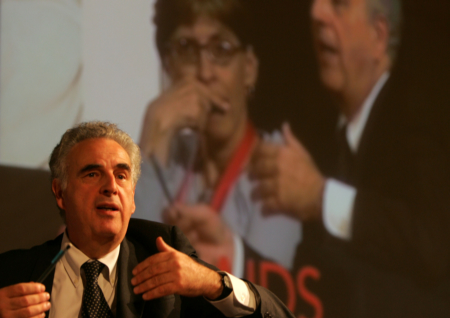An Interview with Dr. Michel Kazatchkine—AIDS in Asia: The View From the Global Fund
 Photo: The Global Fund
Photo: The Global Fund
July 2009—Dr. Michel Kazatchkine is a physician and global health expert who has treated people with HIV/AIDS for more than 20 years. As executive director of the Global Fund to Fight AIDS, Tuberculosis and Malaria, he leads its efforts to expand access to HIV prevention, treatment, and care in the developing world. The Global Fund provides almost a quarter of all international financing for AIDS globally and has supported the provision of lifesaving antiretroviral treatment for two million people.
TREAT Asia Report: You have said that stopping the spread of AIDS in Asia is within our grasp if we have the resources. How can Asian countries best focus their HIV/AIDS programs given global resource limitations?
Dr. Kazatchkine: Certainly resources are constrained right now, but it is crucial that we continue to invest in the fight against HIV/AIDS. If resources remain flat or decrease, we will rapidly lose the gains that we have made in the last eight years—and we have made major progress scaling up prevention and treatment. The Global Fund is currently providing support to 75 percent of those being treated for HIV in Asia. But Asian economies—even in this period of crisis—are showing growth, and we need co-investment from other multilateral organizations and the private sector.
TA Report: Since its launch in 2002, the Global Fund has provided funding to address gaps in national HIV/AIDS programming around the world. Where do the widest gaps in treatment remain?
Dr. Kazatchkine: We need to scale up treatment education. Civil society needs to be aware of what it means to have HIV/AIDS so that people are not afraid and so that those who are infected are compassionately treated. Even among physicians and nurses, there are still so few who are knowledgeable about HIV/AIDS healthcare—in China, and even in countries like Thailand or Cambodia, where Global Fund money has really made spectacular progress in prevention and access to treatment.
Another gap in treatment is related to support programs. People who are affected by HIV/AIDS need social and peer support to help with psychological needs and with practical things like housing and nutrition.
TA Report: The Global Fund and other organizations have made great strides in lowering the cost of first-line antiretroviral medications in resource-limited countries. But many second- and third-line treatments are still prohibitively expensive. How can this issue best be addressed as more people develop resistance to first-line drugs?
Dr. Kazatchkine: Among Global Fund cohorts, which account for three-quarters of all HIV treatment in Asia, less than five percent have had to switch to second-line drugs (based on clinical and immunological monitoring, not on viral load). Those figures are actually a little better than we thought they would be a few years ago.
The Global Fund subsidizes the second-line antiretroviral drugs in non-PEPFAR countries, and there is no PEPFAR in Asia, except in Viet Nam. Our main concern is that these second-line drugs can cost up to 40 times as much as first-line drugs. If we cannot solve this problem, then we will run into impossible dilemmas over whether we only have enough resources to continue supplying drugs to those already in treatment, or whether we can include new patients who are at high risk of dying. But I see progress. China had no second-line drugs one and a half years ago, and now Kaletra and tenofovir are coming into the arsenal.
TA Report: Co-infection with HIV and tuberculosis (TB) is a significant concern in many Asian countries. What are the best ways to address this double burden?
Dr. Kazatchkine: For years, many countries have built coherent and strong national TB programs. But TB complicates the treatment of HIV because some of the drugs needed to treat it are not compatible with some antiretroviral regimens. In coordinating the treatment of the two, we are clearly lagging behind. In Ho Chi Minh City, for example, the TB hospital cannot do HIV testing and counseling. And at the city’s infectious disease hospital, healthcare workers who suspect that someone is infected with TB can hardly even do an x-ray without sending the patient to the TB hospital.
If we do not move faster, there will still be hundreds of thousands of people with HIV who will die every year of treatable TB. The 2009 Global TB Control Report shows an estimated 1.37 million new cases of tuberculosis among HIV-infected people and more than 450,000 deaths. That means one out of every four TB deaths is HIV-related. If we do not improve HIV/TB integration, we have a very high risk of seeing multidrug-resistant TB spread in those populations. Particularly in Asia, there are a number of high-burden countries with huge populations with TB and multidrug-resistant TB. Rather than keeping these systems on parallel tracks, we need to integrate them.
TA Report: Injection drug use is a major driver of the epidemic in Asia and the Pacific. What are the most effective strategies for preventing the spread of the virus among this vulnerable population?
Dr. Kazatchkine: There are so many countries in Asia where injection drug users [IDUs] are considered criminals, thrown in prison, or cannot access prevention or treatment services. But a compelling set of evidence has shown that programs that provide education, therapy, clean needles and syringes—a comprehensive harm reduction package—offer the most effective HIV/AIDS prevention intervention.
In Europe, where we have been implementing harm reduction more comprehensively than in the U.S., IDUs are not becoming infected. In France, IDUs constitute less than two percent of all new infections per year. So it’s like preventing mother-to-child HIV transmission: It’s a problem that has been solved. I don’t see why it couldn’t be solved in Asia as well.